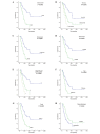Peritumoral edema on magnetic resonance imaging predicts a poor clinical outcome in malignant glioma
- PMID: 26722240
- PMCID: PMC4665258
- DOI: 10.3892/ol.2015.3639
Peritumoral edema on magnetic resonance imaging predicts a poor clinical outcome in malignant glioma
Abstract
Peritumoral edema (PTE), one of the main characteristics of malignant glioma, is a significant contributor to the morbidity and mortality from glioma, however, a recent systematic review suggested that controversy remains with regard to its prognostic value. To further determine whether PTE was a potential prognostic factor on routine pre-operative magnetic resonance imaging (MRI) for malignant glioma, the association between survival and PTE was investigated in the present retrospective review of 109 patients with newly diagnosed supratentorial malignant glioma using MRI data from these routine scans. The Kaplan-Meier method was used to calculate overall survival (OS) in univariate analysis, and COX proportional hazards model was applied to evaluate the effect of pre-operative MRI features on OS in multivariate analysis. The PTE extent, edema shape, degree of necrosis, enhancement extent, pathological grade, patient age, Karnofsky performance status (KPS) and post-operative chemoradiotherapy were associated with OS in the patients with malignant glioma on univariate analysis. Multivariate analysis indicated that the extent of PTE and degree of necrosis shown by pre-operative MRI were independent predictors of OS, in addition to pathological grade, patient age, KPS and post-operative chemoradiotherapy. Moreover, patients with two unfavorable factors (major edema and severe necrosis) exhibited a poorer OS compared with the remainder. In summary, PTE and degree of necrosis, which are easily determined from routine MRI, can be useful for predicting a poor clinical outcome in patients with newly diagnosed malignant glioma.
Keywords: glioblastoma; magnetic resonance imaging; malignant glioma; peritumoral edema; prognosis; survival.
Figures


References
LinkOut - more resources
Full Text Sources
Other Literature Sources
